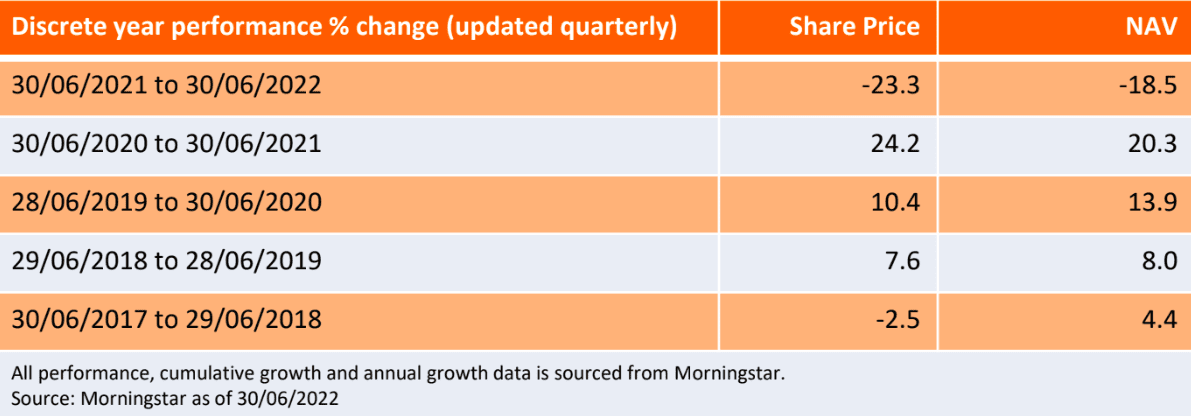
Jamie Ross, Portfolio Manager of Henderson EuroTrust, delivers an update on the Trust highlighting the key drivers of performance over the month and recent portfolio activity.
Macro backdrop
The environment for growth stocks improved once again in July. Following strong performance from growth stocks over the last two months, the gap between the MSCI Europe Value and MSCI Europe Growth has narrowed to about 10% so far this year (-2.2% versus -11.8% respectively).¹ This has occurred alongside a moderation in bond yields and inflation/interest rate expectations. July was also a month in which cyclical equities markedly outperformed more defensive equities for just about the first time this year; it is unclear whether this is a rally from oversold levels for cyclical equities or the start of a more sustainable recovery in economic sentiment.
Trust performance and activity
The Trust had a strong month on both an absolute and a relative basis in July and returned 6.2%, outperforming the FTSE World Europe ex UK Index benchmark which returned 5.1%. The AIC Europe peer group returned 7.3%.¹
Of the two themes described above, the outperformance of the growth style has helped fund performance while the outperformance of cyclicality has probably been a small detractor.
The general theme to stock-level attribution is that the portfolio’s more growth-style holdings outperformed (Hermes, Sartorius and Partners) while the most defensive holdings (Roche and KPN) underperformed. We are also back into earnings season and so the performance of individual companies has also been led by the strength of their reported quarterly performance. Of our top 10 contributors, Hermes, Sartorius and Moncler announced especially strong results, while of the top 10 detractors Hellofresh, Grifols and Amundi reported the weakest results. So far this earnings season, we have had 33 companies reporting and of these, 16 have beaten expectations, 10 have produced neutral results and seven have missed expectations. We have started to see some end-market weakness from some of our holdings, especially from those most exposed to consumer discretionary spending (such as Hellofresh, Adidas and BE Semi); this is not unique to the trust and has been a theme across the market in general.
As with June, July was a fairly uneventful period for trading activity. The general theme of our trading activity was to reduce exposure to some of our stronger performing, more expensive, high-quality defensive growth companies (Nestle, SIG and Combibloc) while adding to slightly less defensive but also less expensive holdings (Kion, CNHI, Allfunds and Danone). Taken together, these trades reflect our view that a number of our most defensive companies are trading at unsustainably high relative valuations, having performed exceptionally well during the sell-off in markets so far in 2022.
We also sold Stellantis and bought Airbus as a replacement in July. For about a year now, we have been concerned that auto companies have been overearning; put simply, Stellantis has recently been delivering 10-15% EBIT margins versus a more usual historic level of 5-7%. The reason for this is that the supply of cars is being severely constrained by supply chain issues, especially with respect to semi-conductors. Constrained supply and still-strong demand have made the pricing environment unusually strong. However, as supplychain issues resolve themselves, we suspect that pricing will come under pressure.
Having sold Stellantis, we replaced it with a higher-quality business with a historically more predictable and less volatile revenue stream, Airbus. We are of the view that the civil aerospace industry represents an area of the market that is only part-way through a natural post-Covid-19 recovery. We already have an investment in Safran (engines) and we have now added this position in Airbus. Airbus operates in a global oligopoly with Boeing and has a substantial multi-year backlog of aircraft orders which should provide it with revenue visibility. Given its past above-average return on investment capital (ROIC) and strong balance sheet, it was trading at what we saw as a very attractive valuation of around 13/14 times its 2023 price-to-earnings (P/E) ratio.
Outlook/strategy
We will continue to retain balance in our exposures by considering two types of business for investment; those where we see the potential for high and sustainable returns that we think are undervalued by the market and those companies where we can see a material improvement in medium-term business prospects.

¹Source: Bloomberg as at 30 June 2022
Glossary ExpandBalance Sheet – A financial statement that summarises a company’s assets, liabilities and shareholders’ equity at a particular point in time. Each segment gives investors an idea as to what the company owns and owes, as well as the amount invested by shareholders. It is called a balance sheet because of the accounting equation: assets = liabilities + shareholders’ equity.
Bond yield – The level of income on a security, typically expressed as a percentage rate. For a bond, this is calculated as the coupon payment divided by the current bond price. Lower bond yields means higher bond prices.
Cyclical – Companies that sell discretionary consumer items, such as cars, or industries highly sensitive to changes in the economy, such as miners. The prices of equities and bonds issued by cyclical companies tend to be strongly affected by ups and downs in the overall economy, when compared to non-cyclical companies.
Earnings before interest and taxes (EBIT) – Earnings before interest and taxes (EBIT) is an indicator of a company’s profitability. EBIT can be calculated as revenue minus expenses excluding tax and interest. EBIT is also referred to as operating earnings, operating profit, and profit before interest and taxes.
Growth investing – Growth investors search for companies they believe have strong growth potential. Their earnings are expected to grow at an above-average rate compared to the rest of the market, and therefore there is an expectation that their share prices will increase in value.
Gross profit margin – Gross profit margin is a metric analysts use to assess a company’s financial health by calculating the amount of money left over from product sales after subtracting the cost of goods sold (COGS).
Return on invested capital (ROIC) – Return on invested capital (ROIC) is a calculation used to assess a company’s efficiency at allocating the capital under its control to profitable investments.
Price-to-earnings (P/E) ratio – A popular ratio used to value a company’s shares, compared to other stocks, or a benchmark index. It is calculated by dividing the current share price by its earnings per share.
Quality investing – Quality investing is an investment strategy based on a set of clearly defined fundamental criteria that seeks to identify companies with outstanding quality characteristics. The quality assessment is made based on soft (e.g. management credibility) and hard criteria (e.g. balance sheet stability).
Value investing – Value investors search for companies that they believe are undervalued by the market, and therefore expect their share price to increase. One of the favoured techniques is to buy companies with low price to earnings (P/E) ratios.
Valuation metrics – Metrics used to gauge a company’s performance, financial health and expectations for future earnings e.g. price to earnings (P/E) ratio and return on equity (ROE).